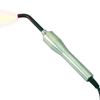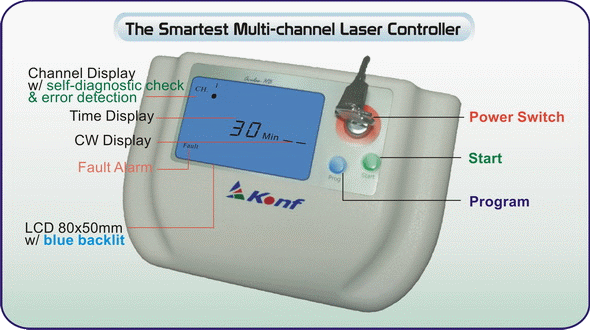 |
 |
 |
 |
 |
 |
 |
 |
|||
|
||||||||||||||||||||||||||||||||||||||||||||||||||||||||||||||||||||||||||||||||||||||||
  |
Aculas®-HB-150D | |
| Red
Laser 635nm/220mW, 660nm/150mW Infrared Laser 808nm/250 ~ 460mW |
|
|
| Operation Environment | 0 ~ 50 °C (32 ~ 122 °F); 10 ~ 95%RH (Non-condensing) |
| No. of Channel | 1 |
| Time Setting | 30 Minutes (Auto Setting) |
| Frequency Setting | Continuous (Auto Setting) |
| Music Alert | Stop and Fault |
| Power Supply | 90 ~ 264V AC,
47Hz ~ 63Hz, Max. 1.0A (115V AC), 0.5A (230V AC) Short Circuit and Overload Protection; Auto Recovery Mode |
| EMC
Directive 93/42/EEC (Operation Environment: Medical Electrical Equipment) Standard Applied: IEC 60601-1 and EC 60601-1-2 |
|
| Medical Device Certificate | ISO 13485: 2003 |
| Shipping Dimensions | 39(L) x 13(W) x 30(H) cm;15.4(L) x 5.1(W) x 11.8(H) in |
| Shipping Weight | 3.3 Kg (7.3 Lbs) |
| Fiber Rod Laser Module | LD-1 | ||
| Laser Material | Semiconductor Laser Diode 635nm…GaAs 660nm…AlGaInP 808nm…AlGaAs |
  |
 |
| Laser
Diode Temperature Rating |
635nm…55 °C 660nm…60 °C 808nm…50 °C |
||
| MTBF of Laser Diode | >5,000 Hours | ||
| Wavelength & Output Power | 635nm…220
mW 660nm…150 mW 808nm…250 mW/460 mW |
||
| Laser Beam Spot Size | 0.5 cm² | ||
| Fiber Material | Fiber Rod; Exchangeable | ||
| Handheld Material | Stainless Steel | ||
| Weight | 340 g (12 ounce) - Cable Included | ||
| Fiber Rod | WF-422 | |
| The fiber rod has high resistance to chemical attacks and is perfectly compatible with the strict hygiene standards called for in dental surgery. The excellent transmission of the fiber rod remains at a consistent high level, even after being subjected to several thousand autoclave and machine washing cycles. |  |
|
| Rod Material | Multi Core Glass Rod | |
| Diameter | 8mm; Bent | |
| Transmission Ratio | > 80% | |
| Carrying Bag | WC-220 | |
| Dimensions | 24(L) x 20(W)
x 8(H) cm 9.4(L) x 7.9(W) x 3.1(H) in. |
 |
| Weight | 0.4 Kg (0.9 Lb) | |
| Laser Safety Goggles | WG-221 | |
| Frame | Plastic |  |
| Lens | Polycarbonate with hard coating | |
| Protection | Side shields | |
| Model
No. Aculas- |
Laser Module |
Red Laser | Infrared Laser | |||
| Wavelength | 635nm | 660nm | 808nm | |||
| Output Power | w/o Fiber Rod | 220mW | 150mW | 250mW | 460mW | |
| w/ Fiber Rod | 170mW | 120mW | 200mW | 370mW | ||
| HB-150D321 | ||||||
| HB-150D611 | ||||||
| HB-150D821 | ||||||
| HB-150D841 | ||||||
Konftec Corporation © Copyright 2017, All Rights Reserved |
| |
||
| ISO 13485 | ||
 Warranty Warranty |
||
 Money
Back Money
Back |
||
| Low Level Lasers in Dentistry | |||
| Dentistry Therapy Protocol | |||
| Aculas-HB-150D User's Guide |
|||
| LLLT Dental Laser Comparison Table | |||








